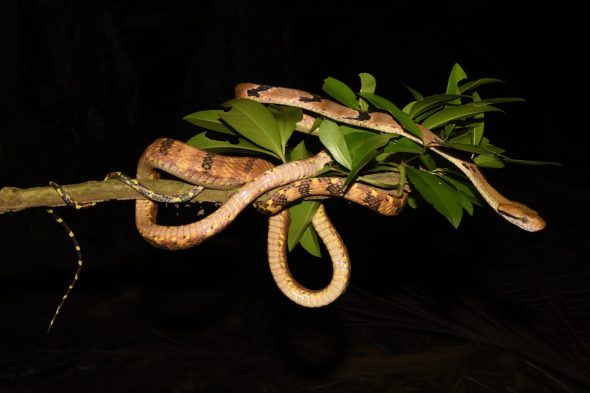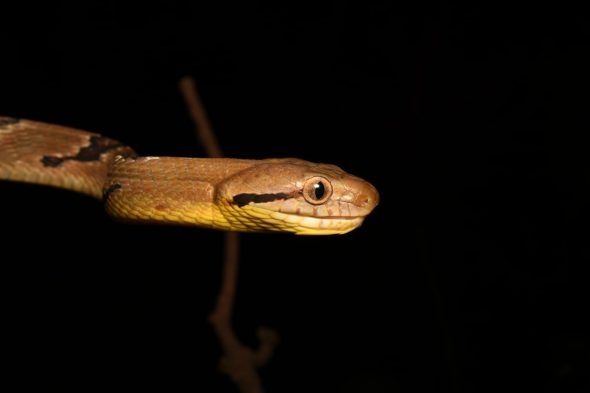Dogtooth Cat Snake
Family Colubridae
Boiga cynodon

A rather long snake. Photo credit: Dr Seow-Choen
Video of a very active snake in locomotion. Video courtesy of Dr Seow-Choen.

Photo credit: Dr Seow-Choen
There are estimated to be more than 5,000 species of snakes in the world. About two third of these living snakes belong to the Family Colubridae. They are a highly diverse group of individuals.
Around our region, peninsular Malaysia is said to have at least 141 snake species on land and in the water. Of these only 16 species of land snake and all 21 species of water snake are significantly venomous.
Dogtooth Cat snake (DTC) is mildly venomous. Its venom usually only cause slight pain and swelling to human when bitten, but is lethal to small birds. It is one of the four cat snake species (Boiga) found in Singapore. The others include the Gold-ringed Cat snake (Boiga melanota) and Jasper cat snake (Boiga jaspidea). The fourth species is the white-spotted cat snake (Boiga drapiezii) that was not seen for a long time but rediscovered in 2009 by Leong T.M., Lim K.K. and Baker N.
DTC got its name because like the cat, its big eye responds with a vertically elliptic pupil in strong light. This elliptic pupil characteristic points to a nocturnal predatory pattern. It has a rounded snout with relatively large front teeth in both upper and lower jaws. Two of these teeth are again larger than the others, giving the impression of being fangs. The real fangs are fixed fangs situated in the rear of the mouth. The large front teeth and big false front fangs (like dog’s canines) may have resulted in its dogtooth name.
DTC is endemic to Asia. It can grow up to 2.8m in length but it looks slender and thin. This is due to the fact that it is compressed side to side (laterally), giving it a prominent vertebra ridge.
Dorsally, it is reddish-brown/dark-brown in color with irregular black bands running transversely. In some you may see additional tan/yellow parallel cross bands. A few may have extra black melanin pigments, resulting in a black looking snake. However they still have the distinctive thick dark streak behind each eye. Ventrally, its belly varies from whitish to light brown.
DTC has a triangular head, much wider than its neck. This can be confused with the head of a viper. It is usually nocturnal and arboreal. It feeds on birds, their eggs, lizards, bats, frogs and rodents. It is oviparous, lays 6-12 eggs in one clutch. The young are independent at hatching and do not receive any maternal care.
DTC are usually found in lowland forest, especially at its edges. It tends to shy away from human habitations but are attracted to chickens, eggs and birds in cages. So chicken keepers beware!
Rats/mice are pests of economic and medical importance. They are important partly because of their very high potential reproductive rate. This can be seen in the recent mice explosion in the rural communities in New South Wales, Australian. Mice can be seen everywhere on the farms, tons and tons of them. Rodents eat up and contaminate the farm produce. Singapore may not have many farms but we have plenty of warehouses for storing our imported food. Hence, rodent population control is of top priority. Many snakes eat rats. There are stories of warehouse owners keeping pythons to keep rat populations down. Rodents are also carriers of diseases like leptospirosis, salmonellosis, scrub typhus, murine typhus and other helminthic sickness.
At least 15 species of local burrowing snakes (Leptotyphlopidae also known as blind snakes) are ecologically important as they help us by eating up termites.
Thus we should leave harmless snakes alone. In fact, more than two thirds of the species in the region are harmless.
Article by Wong Kais
Photos and Video Courtesy of
Dr Francis Seow-Choen
Honorary Research Associate, Sabah Forestry Department, Sabah, Malaysia
Honorary Research Affiliate, Lee Kong Chian Natural History Museum, Singapore
Honorary Research Associate, National Biodiversity Centre, National Parks Board, Singapore
References:
- Nature in Singapore, 2, 487 – 493
- A guide to THE AMPHIBIANS & REPTILES of Singapore by Kelvin KP Lim and Francis LK Lim
- Singapore Biodiversity : An encyclopedia of the Natural Environment and Sustainable Development. Edited by Peter K>L> Ng, Richard T. Corlett and Hugh T.W. Tan © 2011







